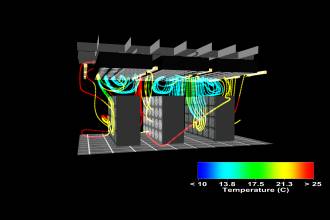Hewlett-Packard公司和Emerson能源系统使用Flovent
日期:2012-06-20
Hewlett-Packard Company and Emerson Energy Systems Validate Use of FLOVENT for Data Center Analysis |
|
In a recent paper1, engineers from Hewlett-Packard Company and Emerson Energy Systems, estimated that the maximum power dissipation from a typical 2-meter computer rack is already 10kW and will soon rise to 20kW given current market pressures and available technology. They concluded that such extreme power densities necessitate extending the well-established practice of performing thermal modeling of computer hardware to the surrounding room environment. Such analysis, they reasoned, could provide useful predictions of rack inlet airflow temperatures and allow hot spots to be located. A study was devised and a prototype data center was built at Hewlett-Packard’s Richardson, Texas facility for this purpose. The data center was constructed using a layout similar to that shown in Figure 1. Emerson’s patented cooling technique called DataCoolTM was developed utilizing overhead heat exchangers co-developed by Emerson and Hewlett-Packard. Three rows of 6 2-meter racks utilizing front-to-back airflow were installed. The center row was oriented with an opposite airflow direction relative to the other two rows; the overhead heat exchangers were oriented similarly so that alternating “hot” and “cold” aisles were created. In this configuration, mixing of hot exhaust and cool supply airstreams is largely avoided allowing the coldest air to reach the computer hardware. The Hewlett-Packard and Emerson Engineers performed FLOVENT simulations; characteristics and quantities including: airflow patterns, speed, rack inlet temperatures, and temperature gradients were compared to experimental data. Good agreement was achieved despite a fairly simplistic representation of the room. Furthermore, FLOVENT revealed features of the room performance that would easily have been missed by experiment alone. For example, one particular circulation pattern and another dead spot “could not have been determined intuitively”.
Figure 1 – Simulation of Airflow In Data Center From Reference 1Reference1) Chandrakant D. Patel, Cullen E. Bash, and Christian Belady (Hewlett-Packard Company) Lennart Stahl and Danny Sullivan (Emerson Energy Systems) Computational Fluid Dynamics Modeling of High Computer Density Data Centers to Assure System Inlet Air Specifications; Proceedings of IPACK'01; July 2001, Kauai, Hawaii, USA |










 沪公网安备 31010602003953号
沪公网安备 31010602003953号